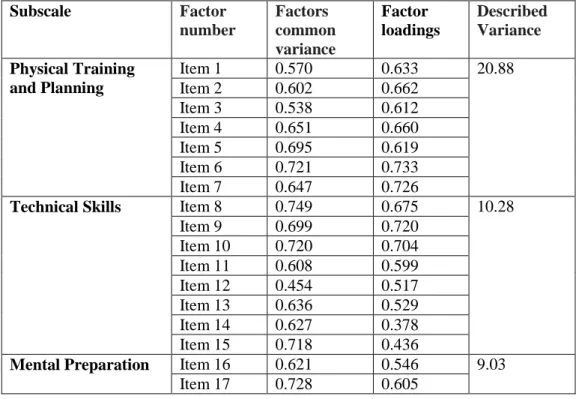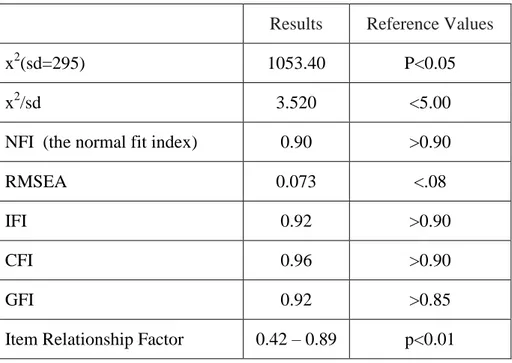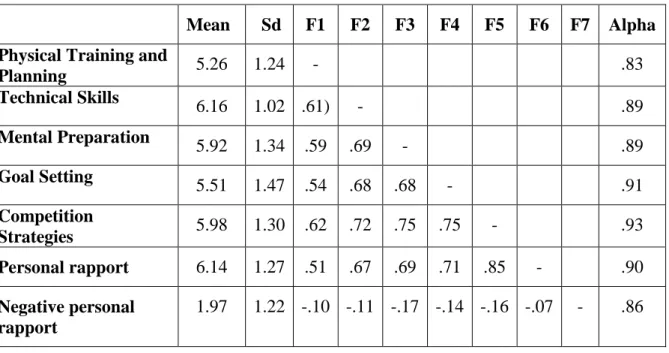Doi : 10.14486/IntJSCS582
Copyright©IntJSCS (www.iscsjournal.com) - 599 Field : Sport Psychology
Type : Research Article
Recieved: 09.04.2016 - Accepted: 02.06.2016
Sporcular için Antrenör Davranışlarını Değerlendirme Ölçeğinin Boşnakça
Uyarlaması (SADDÖ): Geçerlik ve Güvenirlik Çalışması
Osman İMAMOĞLU1, Ahmet Naci DİLEK2, Gürkan ELÇİ3, Mutlu TÜRKMEN3
1Ondokuz Mayıs Üniversitesi, Yaşar Doğu Spor Bilimleri Fakültesi, Samsun, TÜRKİYE 2Ondokuz Mayıs Üniversitesi, Sağlık Bilimleri Enstitüsü, Samsun, TÜRKİYE
3Bartın Üniversitesi, Beden Eğitimi ve Spor Yüksekokulu, Bartın, TÜRKİYE E-Posta: osmani@omu.edu.tr
Öz
Bu çalışmanın amacı “Sporcular için Antrenör Davranışlarını Değerlendirme Ölçeğinin” (SADDÖ; Côté, ve diğ.,1999) Boşnakça uyarlamasının geçerlik ve güvenirliğini sınamaktır. Bu amaçla SADDÖ Boşnakça’ya çevrildikten sonra 14-36 yaş aralığında 82’i erkek (%64,5), 45’i kadın (%35,5) olmak üzere toplam 127 sporcuya uygulanmıştır. Ölçek 7 alt boyut ve 47 maddeden oluşmaktadır ve 7’li Likert derecelendirme içermektedir. Ölçeğin geçerliğini belirlemek amacı ile elde edilen verilerle önce açımlayıcı faktör analizi yapılarak faktör yüklenmelerine bakılmıştır. Ardından açımlayıcı faktör analizinde belirtilen faktörlerin modele uygunluğunu test etmek üzere veriler doğrulayıcı faktör analizi ile incelenmiştir. Açımlayıcı faktör analizi sonuçları özgün ölçek ile tutarlılık göstererek maddeler 7 boyut altında toplanmıştır. Bu 7 faktör toplam değişkenliğin % 67,89’unu açıklamaktadır. Doğrulayıcı faktör analizi sonuçlarına bakıldığında (x2
/sd= 3.520, NFI= 0.90, RMSEA= 0.073, CFI= 0.96 ve IFI= 0.92, GFI= 0.92) 7 faktörlü bir modelle kabul edilebilir bir uygunluk gösterdiği ortaya konmuştur. Ölçeğin 7 boyutunun Cronbach alfa değerleri. 81 ile .92 arasında, toplam değer ise .95’dir. Bu sonuçlar, Boşnakça SADDÖ’nün iç tutarlık ve yapı geçerliği açısından ilgili araştırmalarda kullanılmaya uygun olduğunu göstermiştir.
Copyright©IntJSCS (www.iscsjournal.com) - 600
The Adaptation of Coaching Behavior Scale for Sport (CBS-S) into Bosnian
Language: A Validity and Reliability Study
Abstract
The aim of the study was to test the construct validity and reliability of the Turkish version of Coaching Behavior Scale for Sport (CBS-S; Côté, et al., 1999). Totally, 88 men (%64, 5) and 45 women (%35, 5) athletes aged between 14-36 years old completed the Bosnian version of CBS-S. CBS-S includes 47 items and 7 sub-dimensions. Each item is rated in 7 point likert type scale. Exploratory factor analysis was conducted to examine the factorial validity of the scale. The findings of the exploratory factor analysis were consistent with the original scale and 7 sub-dimensions were found. Total variance was calculated as % 67,89. Confirmatory factor analysis results (x2/sd= 3.520, NFI= 0.90, RMSEA= 0.073, CFI= 0.96 and IFI= 0.92, GFI= 0.92) indicated that there was an acceptable fit index values between 7 factor model. Cronbach alpha value of the 7 dimensions of the scale were between .81 and .92, the total
value is .95. Results of the study showed that Bosnian version of the CBS-S has good internal
consistency and construct validity to use in related studies.
Copyright©IntJSCS (www.iscsjournal.com) - 601 Introduction
Mallett (2007) described high-performance coaching as “a complex, social, and dynamic activity that is not easily represented as a set of tangible and predictable processes … and might be considered within a broader set of relations: the interdependence between (a) the coaching tasks undertaken by coaches, (b) coaches’ relations with other people (e.g., athletes, other coaches, parents), and (c) the coaching situation and context in which they operate”. The complexity of high-performance coaching necessitates ongoing cycles of planning, monitoring, implementing, and reviewing to respond to the dynamic characteristics of coaching (Bowes and Jones,2006). Therefore, the work demands for high-performance coaches are significant (Lyle,2002). Hence, assessing their work should be done using a multi-dimensional behavioral framework to better reflect their performance. Unfortunately, despite these difficult and complex challenges in high performance coaching, evaluation of sports coaches’ effectiveness is mainly focused on performance outcomes such as win-loss records (Mallett and Côté,2006, Koh et al.,2009).
Côté et al. (1999) have developed the Coach Behaviors Scale for Sport (CBS-S) as a tool for measuring the quality of high-performance coaches’ behaviors. This model of coaching behaviors is suitable for all forms of coaching, including participation and performance (Koh et al,2014). It aims to collect quantitative data on coaches’ behaviors, providing feedback to them and guiding their personal development. It has been used in countries like Canada, the USA, Turkey and Australia and found to be useful (Mallett and Côté,2006).
High-performance coaching is a highly complex vocation and is bounded by context and culture (Lyle,2002). Research findings from the CBS-S conducted in Canada, Australia, and the USA cannot be generalized to the Europa context. Furthermore, Côté et al. recommended that “cross cultural validation studies of the CBS-S should be carried out” (Côté et al.,1999) to better understand and evaluate the work of high-performance coaches (Koh et al.,2009). The CBS-S measures seven dimensions of a coach’s consistent involvement with the athletes in the complex training and competition coaching environments. They are Physical Training and Planning (the coach’s involvement in the athlete’s physical training and conditioning for training and competition), Technical Skills (the coach’s provisions of feedback, demonstration, and cues), Goal Setting (the coach’s involvement in identifying, developing, and monitoring the athlete’s goals), Mental Preparation (the coach’s involvement in providing the athlete with advice on how to perform well under pressure), Competition Strategies (the coach’s constructive interaction with the athlete in competition), Personal Rapport (the coach’s approachability, availability, and understanding of the athlete), and Negative Personal Rapport (the coach’s use of negative techniques such as fear and yelling for coaching), (Koh et al,2014).
Therefore, a study was conducted in Bosnian to examine the ecological validity of the CBS-S in the Bosnian context. For a research study to possess ‘ecological validity’, the methods, materials and setting of the study must approximate the real-life situation that is under investigation (Gratton and Jones,2004, Koh and et al,2009). Therefore, the purpose of this study was to examine the behaviors of high-performance taekwondo coaches using the existing CBS-S with the national team coaches, players and team managers in the Bosnian context.
Copyright©IntJSCS (www.iscsjournal.com) - 602 Method
Coaching Behavior Scale for Sport (CBS-S; Côté, et al., 1999). Totally, 88 men (%64, 5) and 45 women (%35, 5) athletes aged between 14-36 years old completed the Bosnian version of CBS-S. CBS-S includes 47 items and 7 sub-dimensions. Each item is rated in 7 point Likert type scale. The Coaching Behavior Scale for Sport (CBS-S) is an instrument that assesses coaching behaviors from athletes’ perspectives. It has been modified and the current version of the CBS-S consists of 47 items, 2 measuring seven dimensions of coaching behaviors: Physical Training and Planning (7 items), Technical Skills (8 items), Goal Setting (6 items), Mental Preparation (5 items), Competition Strategies (7 items), Personal Rapport (6 items), and Negative Personal Rapport (8 items). Respondents were asked to rate their coach’s behaviors by responding to each of the items on a 7-point Likert scale, ranging from 1 (never) to 7 (always).(Koh et al,2014). The data were analyzed using SPSS (Version 20.0) producing basic statistics. Statistical significance was set at P < 0.05. Reliability was analyzed by calculating Cronbach alpha coefficient (Cα). Homogeneity was analyzed by factor analysis with obliging rotation (percentage of explained variance (% VAR). The sensitivity of measuring instruments was tested with Kolmogorov - Smirnov test to determine normality (KS).
Results and Discussion
During the validation of the first and last dimension of the CBS-S questionnaire (Physical Training and Planning and Negative Personal Report) factor analysis resulted in two significant components. CBS-S are exploratory factor analysis to examine the factorial validity of the in table 1. The proposed new dimension and items were content analyzed.
Table 1. Exploratory factor analysis to examine the factorial validity of the scale
Subscale Factor number Factors common variance Factor loadings Described Variance Physical Training and Planning Item 1 0.570 0.633 20.88 Item 2 0.602 0.662 Item 3 0.538 0.612 Item 4 0.651 0.660 Item 5 0.695 0.619 Item 6 0.721 0.733 Item 7 0.647 0.726
Technical Skills Item 8 0.749 0.675 10.28
Item 9 0.699 0.720 Item 10 0.720 0.704 Item 11 0.608 0.599 Item 12 0.454 0.517 Item 13 0.636 0.529 Item 14 0.627 0.378 Item 15 0.718 0.436
Mental Preparation Item 16 0.621 0.546 9.03
Copyright©IntJSCS (www.iscsjournal.com) - 603 Item 18 0.702 0.668
Item 19 0.759 0.635 Item 20 0.752 0.673
Goal Setting Item 21 0.737 0.608 8.69
Item 22 0.736 0.618 Item 23 0.753 0.740 Item 24 0.752 0.704 Item 25 0.781 0.688 Item 26 0.642 0.651 Competition Strategies Item 27 0.700 0.663 8.32 Item 28 0.659 0.602 Item 29 0.738 0.718 Item 30 0.652 0.689 Item 31 0.725 0.692 Item 32 0.790 0.775 Item 33 0.744 0.750
Personal rapport Item 34 0.724 0.735 7.65
Item 35 0.591 0.627 Item 36 0.633 0.699 Item 37 0.598 0.600 Item 38 0.747 0.812 Item 39 0.716 0.806 Negative personal rapport Item 40 0.428 0.557 3.01 Item 41 0.468 0.580 Item 42 0.529 0.695 Item 43 0.630 0.755 Item 44 0.894 0.938 Item 45 0.874 0.925 Item 46 0.835 0.891 Item 47 0.636 0.604 Total announced Variance 67,89 (KMO: 0.88; x2:5168.457; p<0.05)
Physical Education and Planning load factor was found to be between 0,662 and 0,733.
Factor loadings; Technical Skills has found that the 0,454 and 0,749. Mental Preparation load
factor was found to be between 0,621 and 0,759. Factor loadings; Goal Setting has found that
the 0,642 and 0,781. Competition Strategies has found that the 0,652 and 0,790. Factor
loadings; Personal rapport has found that the 0,591 and 0,747. Negative personal rapport has
found that the 0,428 and 0,894 (Table 1). Factor loading is deemed sufficient in the literature
to be greater than 0, 40 (Field, 2000). The findings of the exploratory factor analysis were
consistent with the original scale and 7 sub-dimensions were found. Total variance was calculated as % 67,89
Copyright©IntJSCS (www.iscsjournal.com) - 604 Confirmatory Factor Analysis
Confirmatory factor analysis of the square (x2) = 1053.40 and statistically p <0.05 significant level and 295 degrees of freedom is calculated. x2 / SD ratio is calculated as 3,520. Absolute harmony of the index; GF value was found to be 0,92.
Table 2. Confirmatory Factor Analysis Findings for CBS-S
Results Reference Values
x2(sd=295) 1053.40 P<0.05
x2/sd 3.520 <5.00
NFI (the normal fit index) 0.90 >0.90
RMSEA 0.073 <.08
IFI 0.92 >0.90
CFI 0.96 >0.90
GFI 0.92 >0.85
Item Relationship Factor 0.42 – 0.89 p<0.01
The root mean square error of approximation (RMSEA) corrects the tendency of the χ2 to reject models with large same size or number of variables. A lower RMSEA (<.05) value indicates a good fit and it is often reported with a confidence level at 95% level to account for sampling errors associated with the estimated RMSEA. A widely used index example is the Comparative Fit Index (CFI) which indicates the relative lack of fit of a specified model versus the baseline model. It is normed and varies from 0 to 1, with higher values representing better fit. CFI is widely used because of its strengths, including its relative insensitivity to model complexity (Khine,2013). In this study, Confirmatory factor analysis results (x2/sd= 3.520, NFI= 0.90, RMSEA= 0.073, CFI= 0.96 and IFI= 0.92, GFI= 0.92) indicated that there was an acceptable fit index values between 7 factor model. Item Relationship Factor is between 0, 42 and 0, 89 (Table 2).
Copyright©IntJSCS (www.iscsjournal.com) - 605 Results for Reliability
Table 3. CBS-S Factor loadings and residuals in exploratory structural equation modeling
Mean Sd F1 F2 F3 F4 F5 F6 F7 Alpha
Physical Training and
Planning 5.26 1.24 - .83 Technical Skills 6.16 1.02 .61) - .89 Mental Preparation 5.92 1.34 .59 .69 - .89 Goal Setting 5.51 1.47 .54 .68 .68 - .91 Competition Strategies 5.98 1.30 .62 .72 .75 .75 - .93 Personal rapport 6.14 1.27 .51 .67 .69 .71 .85 - .90 Negative personal rapport 1.97 1.22 -.10 -.11 -.17 -.14 -.16 -.07 - .86
Physical Training and Planning was found mean 5, 26, Technical Skills 6, 16 and Mental Preparation 5, 92. Goal Setting was found mean 5, 51, Competition Strategies 5, 98, Personal rapport 6, 14 and Negative personal rapport 1, 97 (Table 3). As expected, all CBS-S factors except for Negative Personal Rapport were positively correlated with Coaching Satisfaction. These results supported the concurrent validity of the CBS-S responses.
The seven factors of the CBS-S are the following (Mallet and Cote, 2006):
1. Physical Training and Planning (PTP; seven items about the coach’s involvement in the athlete’s physical training and planning for training and competition).
2. Goal Setting (GS; six items assessing the coach’s involvement in the identification, development, and monitoring of the athlete’s goals).
3. Mental Preparation (MP; five items focusing on how the coach helps the athlete to perform under pressure, stay focused, and be confident).
4. Technical Skills (TS; eight items about coaching feedback, demonstration, and cues)
5. Personal Rapport (PR; six items assessing the approachability, availability, and understanding of the coach).
6. Negative Personal Rapport (NPR; eight items examining the coach’s use of negative techniques such as fear and yelling).
7. Competition Strategies (CS; seven items focusing on the coach’s interaction with the athlete in competition).
Copyright©IntJSCS (www.iscsjournal.com) - 606 Conclusion
In order to resolve this gap in the literature, the factor structure of the CBS-S was carefully examined in the present study for Bosnian taekwondo athletes by using approaches. The results from both approaches indicated that the seven-factor structure model adequately represented the CBS-S responses. In addition to model assessment as a whole, convergent and discriminant validity of the seven factors was supported through the examination of individual parameter estimates. Internal consistency estimates for the seven factors were also found to be satisfactory and indicated that all subscales were internally consistent. There are several practical implications from this study. The CBS-S has been considered practically useful to provide feedback to coaches about their practice in taekwondo sport settings. Results of the study showed that Bosnian version of the CBS-S has good internal consistency and construct validity to use in related studies.
REFERENCES
Bowes I and Jones R L, Working at the Edge of Chaos: Understanding Coaching as a Complex, Interpersonal System, The Sport Psychologist, 2006, 20, 235-245.
Côté J, Yardley J, Hay J, Sedgwick W. and Baker J, An Exploratory Examination of the Coaching Behavior Scale for Sport, Avante, 1999, 5, 82-92.
Field A, Discovering Statistics using SPSS for Windows. London – Thousand Oaks –New Delhi: Sage publications. 2000.
Gratton C and Jones I, Research Methods for Sport Studies, Routledge, London, 2004.
Khine S.M, Application of Structural Equation Modeling in Educational Research and Practice, ISBN 978-94-6209-330-0, Published by: Sense Publishers, P.O. Box 21858, 3001 AW Rotterdam, The Netherlands, https://www.sensepublishers.com/2013.
Koh K T, Mallett C and Wang C K J, Examining the Ecological Validity of the Coaching Behavior Scale (Sports) for Basketball, International Journal of Sports Science & Coaching Volume 4, Number 2, 2009, 260-272
Koh K T, Kawabata M, and Mallett C J, The Coaching Behavior Scale for Sport:Factor Structure Examination for Singaporean Youth Athletes, International Journal of Sports Science & Coaching, Volume 9 · Number 6,2014,1311-1324
Lyle J, Sports Coaching Concepts: A Framework for Coaches’ Behavior, Routledge, London, 2002.
Mallett C J, Modelling the Complexity of the Coaching Process: A Commentary.
International Journal of Sport Science and Coaching, 2007, 2, 419-421.
Mallett C J. and Côté J, Beyond Winning and Losing: Guidelines for Evaluating High Performance Coaches, The Sports Psychologist, 2006, 20, 213-221.


